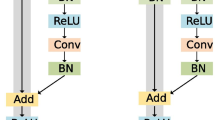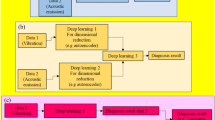Abstract
Background
Condition monitoring (CM) data obtained from practical applications often demonstrate non-stationary characteristics attributing to changing speed or/and loading conditions. CM data can also be affected by noise contamination as a result of machine operating and background noise. This then poses a challenge in the development of an operative technique for practical machine fault diagnostic.
Method
Aiming to address this issue, this study presents an automated fault diagnosis technique for varying speed bearings using Synchroextracting Transform (SET) and deep residual network (DRN). In this approach, SET is utilized to process the non-stationary signals to yield the desired time–frequency representations of the bearing data. The time–frequency graphs are then served as the feature set in the DRN network for training and fault classification.
Results
The classification result based on an experimental bearing dataset shows that the proposed technique can yield a highly accurate result for fault diagnosis of varying speed bearings. Gaussian white noise having a signal-to-noise ratio ranging from 0 to − 8 dB is also added onto the bearing CM data in separate simulations to evaluate the robustness of the proposed technique in dealing with industrial data.
Conclusion
The diagnostic result shows that the technique presented in this study can pertain a satisfying accuracy when the bearing signals are tainted by strong background noise.













Similar content being viewed by others
References
Yu K, Lin TR, Tan JW (2017) A bearing fault diagnosis technique based on singular values of EEMD spatial condition matrix and Gath-Geva clustering. Appl Acoust 121:33–45
Feng Z, Zuo MJ (2012) Vibration signal models for fault diagnosis of planetary gearboxes. J Sound Vib 331:4919–4939
Ni Q, Ji JC, Feng K et al (2020) A novel correntropy-based band selection method for the fault diagnosis of bearings under fault-irrelevant impulsive and cyclostationary interferences. Mech Syst Signal Process 153:107498
Ni Q, Ji JC, Feng K et al (2022) A fault information-guided variational mode decomposition (FIVMD) method for rolling element bearings diagnosis. Mech Syst Signal Process 164:108216
Lei YG, Lin J, Zuo MJ, He Z (2014) Condition monitoring and fault diagnosis of planetary gearboxes: a review. Measurement 48:292–305
Liu R, Yang B, Zio E, Chen X (2018) Artificial intelligence for fault diagnosis of rotating machinery: a review. Mech Syst Signal Process 108:33–47
Jia F, Lei Y, Lin J, Zhou X, Lu N (2016) Deep neural networks: a promising tool for fault characteristic mining and intelligent diagnosis of rotating machinery with massive data. Mech Syst Signal Process 72:303–315
Widodo A, Yang BS (2007) Support vector machine in machine condition monitoring and fault diagnosis. Mech Syst Signal Process 21:2560–2574
Aydmj T, Duin RPW (1999) Pump failure determination using support vector data description. Lecture notes in computer science, pp 415–425
Hu Q, He Z, Zhang Z, Zi Y (2007) Fault diagnosis of rotating machinery based on improved wavelet package transform and SVMs ensemble. Mech Syst Signal Process 21:688–705
McCulloch WS, Pitts W (1990) A logical calculus of the ideas immanent in nervous activity. Bull Math Biol 52:99–115
Zhang Y, Ding X, Liu Y, Griffin PJ (1996) An artificial neural network approach to transformer fault diagnosis. IEEE Trans Power Deliv 11:1836–1841
Hinton GE, Salakhutdinov RR (2006) Reducing the dimensionality of data with neural networks. Science 313:504–507
LeCun Y, Bengio Y, Hinton G (2015) Deep learning. Nature 521:436–444
LeCun Y, Boser B, Denker JS et al (1990) Handwritten digit recognition with a back-propagation network. Adv Neural Inf Process Syst 88:396–404
Bengio Y, Lamblin P, Popovici D, Larochelle H (2007) Greedy layerwise training of deep networks. Adv Neural Inf Process Syst 19:153–160
Lu C, Wang ZY, Qin WL (2017) Fault diagnosis of rotary machinery components using a stacked denoising autoencoder-based health state identification. Signal Process 130:377–388
Zhao D, Liu S, Gu D (2019) Enhanced data-driven fault diagnosis for machines with small and unbalanced data based on variational auto-encoder. Meas Sci Technol 31:035004
Ince T, Kiranyaz S, Eren L (2016) Real-time motor fault detection by 1-D convolutional neural networks. IEEE Trans Ind Electron 63:7067–7075
Zhang W, Li C, Peng G (2018) A deep convolutional neural network with new training methods for bearing fault diagnosis under noisy environment and different working load. Mech Syst Signal Process 100:439–453
Jing LY, Zhao M, Li P, Xu X (2017) A convolutional neural network based feature learning and fault diagnosis method for the condition monitoring of gearbox. Measurement 111:1–10
Janssens O, Slavkovikj V, Vervisch B (2016) Convolutional neural network based fault detection for rotating machinery. J Sound Vib 377:331–345
Xie Y, Zhang T (2017) Fault diagnosis for rotating machinery based on convolutional neural network and empirical mode decomposition. Shock Vib 2017:1–10
Yang T, Yu X, Li G et al (2020) An early fault diagnosis method based on the optimization of a variational modal decomposition and convolutional neural network for aeronautical hydraulic pipe clamps. Meas Sci Technol 31:055007
Liu C, Cheng G, Chen X (2018) Planetary gears feature extraction and fault diagnosis method based on VMD and CNN. Sensors 18(5):1523
Yu J, Xu Y, Liu K (2019) Planetary gear fault diagnosis using stacked denoising autoencoder and gated recurrent unit neural network under noisy environment and time-varying rotational speed conditions. Meas Sci Technol 30:095003
Li X, Li J, Qu Y, He D (2019) Gear pitting fault diagnosis using integrated CNN and GRU network with both vibration and acoustic emission signals. Appl Sci 9(4):768
Pan H, He X, Tang S (2018) An improved bearing fault diagnosis method using one-dimensional CNN and LSTM. J Mech Eng 64:443–452
Verstraete D, Ferrada A, Droguett EL, Meruane V, Modarres M (2017) Deep learning enabled fault diagnosis using time-frequency image analysis of rolling element bearings. Shock Vib 2017:1–12
Ma P, Zhang H, Fan W (2019) A novel bearing fault diagnosis method based on 2D image representation and transfer learning-convolutional neural network. Meas Sci Technol 30:055402
Li H, Zhang Q, Qin XR (2018) Fault diagnosis method for rolling bearings based on short-time Fourier transform and convolution neural network. J Vib Shock 37:124–131
Chen RX, Huang X, Yang LX (2018) Rolling bearing fault identification based on convolution neural network and discrete wavelet transform. J Vib Eng 31:883–891
Yu K, Lin TR, Ma H, Li X (2020) A multi-stage semi-supervised learning approach for intelligent fault diagnosis of rolling bearing using data augmentation and metric learning. Mech Syst Signal Process 146:107043
Yu G, Yu M, Xu C (2017) Synchroextracting transform. IEEE Trans Ind Electron 64:8042–8054
He K, Zhang X, Ren S (2016) Deep residual learning for image recognition. In: Proceedings of the IEEE conference on computer vision and pattern recognition, pp 770–778
LeCun Y, Bottou L, Bengio Y (1998) Gradient-based learning applied to document recognition. Proc IEEE 86:2278–2324
Krizhevsky A, Sutskever I, Hinton GE (2012) ImageNet classification with deep convolutional neural networks. Adv Neural Inf Process Syst 2012:1097–1105
He K, Zhang X, Ren S (2016) Identity mappings in deep residual networks. In: European conference on computer vision. Springer, Cham, pp 630–645
Rumelhart DE, Hinton GE, Williams RG (1986) Learning representations by back-propagating errors. Nature 323:533–536
Ioffe S, Szegedy C (2015) Batch normalization: Accelerating deep network training by reducing internal covariate shift. arXiv:1502.03167
Lin TR, Kim E, Tan ACC (2013) A practical signal processing approach for condition monitoring of low speed machinery using Peak-Hold-Down-Sample algorithm. Mech Syst Signal Process 36:256–270
Zhang W, Peng G, Li C, Chen Y, Zhang Z (2017) A new deep learning model for fault diagnosis with good anti-noise and domain adaptation ability on raw vibration signals. Sensors 17:425
Jiang G, He H, Yan J, Xie P (2018) Multiscale convolutional neural networks for fault diagnosis of wind turbine gearbox. IEEE Trans Ind Electron 66:3196–3207
Maaten LVD, Hinton G (2008) Visualizing data using t-SNE. J Mach Learn Res 9:2579–2605
Acknowledgements
Financial supports from Qingdao Municipal Government through the Qingdao innovative leadership program (181219zhc) and the 111 project from the Ministry of Science and Technology of China (D21017) for this work are gratefully appreciated.
Author information
Authors and Affiliations
Corresponding author
Ethics declarations
Conflict of interest
On behalf of all contributing authors, I declare that there is no conflict of interest for this work. Tian Ran Lin: The corresponding author, and on the behalf of all authors.
Additional information
Publisher's Note
Springer Nature remains neutral with regard to jurisdictional claims in published maps and institutional affiliations.
Part of the materials included in this manuscript was presented in APARM 2020 conference, 20–23, August 2020, Vancouver, Canada.
Rights and permissions
About this article
Cite this article
Sang, K.X., Shang, J. & Lin, T.R. Synchroextracting Transform and Deep Residual Network for Varying Speed Bearing Fault Diagnostic. J. Vib. Eng. Technol. 11, 343–353 (2023). https://doi.org/10.1007/s42417-022-00584-y
Received:
Revised:
Accepted:
Published:
Issue Date:
DOI: https://doi.org/10.1007/s42417-022-00584-y




